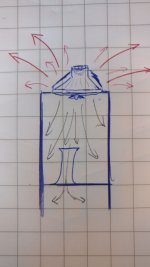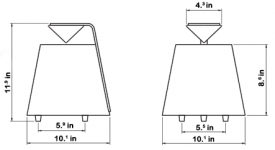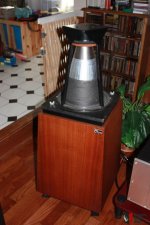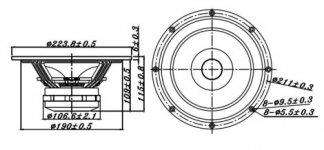View attachment 806149
Helloo!
Long time lurker first time poster. Not sure whether this is the right forum, please move if appropriate!
The case: I'm designing this omnidirectional vented box (refer to image). The dispersion of sound into the room is mostly coming from the back of the speaker, which will (hopefully) radiate musical goodness in all directions. I'm a bit afraid though that the SPL response curve from the back side of the driver might be very different to the curve of the front side, if one was to measure it. Especially since I'll be using a full range driver which has a whizzer cone on the front side (tangband w8-1808 fyi), and obviously not on the back haha. I only need dispersion up to 10kHz though. But I'm wondering whether it will produce tones up to 10kHz from the back
The question: What kind of alterations in response curve can I expect? (comparing the back wave to the front wave). How much treble will I lose?
It's more a technical question than a full-range question so I thought I'd post it here... Help this fella out! 😎
Thanks!!
Helloo!
Long time lurker first time poster. Not sure whether this is the right forum, please move if appropriate!
The case: I'm designing this omnidirectional vented box (refer to image). The dispersion of sound into the room is mostly coming from the back of the speaker, which will (hopefully) radiate musical goodness in all directions. I'm a bit afraid though that the SPL response curve from the back side of the driver might be very different to the curve of the front side, if one was to measure it. Especially since I'll be using a full range driver which has a whizzer cone on the front side (tangband w8-1808 fyi), and obviously not on the back haha. I only need dispersion up to 10kHz though. But I'm wondering whether it will produce tones up to 10kHz from the back
The question: What kind of alterations in response curve can I expect? (comparing the back wave to the front wave). How much treble will I lose?
It's more a technical question than a full-range question so I thought I'd post it here... Help this fella out! 😎
Thanks!!
Attachments
Last edited:
Most of the treble will be radiated downwards and lost. As you propose it, the response woulld be ragged and dull.
The usual way to produce an onmidirectional speaker is to have the driver firing upwards into a conical or exponentially shaped reflector.
The usual way to produce an onmidirectional speaker is to have the driver firing upwards into a conical or exponentially shaped reflector.
Thank you for your response Galu! 🙂
Yes I have thought about that. The traditional way loses sensitivity though (about 3dB) as opposed to this nontraditional design, which aspires to disperse sound in a way a Walsh-driver would
I'm mostly wondering whether the curve would be dropping off starting at 8kHz or so (which would be fine), or rather 3-4k or so
I'm using a supertweeter that I want to be bringing in at ~8-10kHz
Regards, Raoul
Yes I have thought about that. The traditional way loses sensitivity though (about 3dB) as opposed to this nontraditional design, which aspires to disperse sound in a way a Walsh-driver would
I'm mostly wondering whether the curve would be dropping off starting at 8kHz or so (which would be fine), or rather 3-4k or so
I'm using a supertweeter that I want to be bringing in at ~8-10kHz
Regards, Raoul
On axis (which you will not be) the rear radiation typically loses top end. A lot of that is due to shading by the magnet and basket. Off axis it's harder to know, but think of the response you'd get far off axis from the front of the driver. There won't be much top end.
I can't imagine you'd get anywhere near 10kHz at the listening position,
I can't imagine you'd get anywhere near 10kHz at the listening position,
I'm afraid the Walsh driver is a completely different kettle of fish Raoul, being designed specifically for its omnidirectional task.aspires to disperse sound in a way a Walsh-driver would
That's not something that could be imitated by the rear radiation pattern of a driver of standard form.
Attachments
Yeah a Walsh driver is very different
These guys seem to have done it
YouTube
But it should be possible to disperse evenly up to the midrange, right? I mean, a cone does move in 2 directions. My doubt is how far it'll extend into the treble. But I know it's not that simple and I would like to find out what it is that I'm missing 😕
God I wish I had the money to buy Dale Harders' omni speakers
These guys seem to have done it
YouTube
But it should be possible to disperse evenly up to the midrange, right? I mean, a cone does move in 2 directions. My doubt is how far it'll extend into the treble. But I know it's not that simple and I would like to find out what it is that I'm missing 😕
God I wish I had the money to buy Dale Harders' omni speakers

Again, that's a purpose built Walsh speaker. Look at the height of that pyramid shaped, inverted cone and its large, unobstructed area which radiates treble energy in all directions.These guys seem to have done it
YouTube
The cones of ordinary speakers are quite shallow by comparison and would tend to direct the treble energy upwards where it will be masked by the magnet assembly.
Yes, the Walsh is very different, it's more a bending mode speaker. And look at the shape of that cone.
I looked for some off axis measurements of the tangband w8-1808 and didn't see any, but similar 8" fullrange speakers are as much as -20dB at 10K 45 degrees off axis. And that's the front, whizzer cone and all. I would guess you'd be at least 45 degrees off axis with your setup and playing off the back.
FWIW, I think the W8-1808 is a bad choice for this. It's a lovely driver, but all that money for a driver that has been optimized for fullrange from the front of the driver will just be going to waste. That big pretty magnet isn't likely to help, either.
I looked for some off axis measurements of the tangband w8-1808 and didn't see any, but similar 8" fullrange speakers are as much as -20dB at 10K 45 degrees off axis. And that's the front, whizzer cone and all. I would guess you'd be at least 45 degrees off axis with your setup and playing off the back.
FWIW, I think the W8-1808 is a bad choice for this. It's a lovely driver, but all that money for a driver that has been optimized for fullrange from the front of the driver will just be going to waste. That big pretty magnet isn't likely to help, either.
Yes, look how shallow the cone is - as well as its parabolic shape which will direct treble energy from the rear of the cone into the obstructive magnet assembly and basket arms.FWIW, I think the W8-1808 is a bad choice for this.
Attachments
Yeah I was fearing as much. Hearing your opinions settles the matter for me. Instead of constantly weighing possible options in my head, I now have a clearer image
I kinda want my full range to go quite loud, louder than usual, which is why I skewed away from traditional omni design, which trades SPL for its omni benefits
I'll try some other approaches
Thanks all!
Regards,
Raoul
I kinda want my full range to go quite loud, louder than usual, which is why I skewed away from traditional omni design, which trades SPL for its omni benefits
I'll try some other approaches
Thanks all!
Regards,
Raoul
I don't want to discourage from the project, just don't want you to go down a wrong, and expensive, road. The project is certainly worthwhile. Here's why I think so.
A few years back I was one of three judges at the Part Express speaker contest. Don Keele (JBL) and Jerry McNutt (Eminence) were the others judges. We heard a lot of speakers that day, but only a few were memorable. One was an OHM top that someone had put on his own woofer, very similar to the original style, but with some overall tweaks. Wow, it really stood out! All three of us immediately turned to each other to comment on it. It had the most amazing, solid, pinpoint stereo image of any speaker in the contest. I had no idea that omni speakers could do that.
Even if you never achieve that, I still think there is a lot of promise in that style of speaker.
A few years back I was one of three judges at the Part Express speaker contest. Don Keele (JBL) and Jerry McNutt (Eminence) were the others judges. We heard a lot of speakers that day, but only a few were memorable. One was an OHM top that someone had put on his own woofer, very similar to the original style, but with some overall tweaks. Wow, it really stood out! All three of us immediately turned to each other to comment on it. It had the most amazing, solid, pinpoint stereo image of any speaker in the contest. I had no idea that omni speakers could do that.
Even if you never achieve that, I still think there is a lot of promise in that style of speaker.
Owning Ohm Walshes, and having built a few Walsh-style speakers, I can tell you a few things.
First you will lose 6db from the half-space spec. We often look at the baffle step backwards- it's a gain as you transition to half-space, not a loss(but we measure drivers in half-space). The lowest frequencies are omni with a gain as the baffle becomes large enough relative to wavelength to support the wave.
Of course, with 360 degree horizontal dispersion, no adjustment is needed.
As to drivers, the smaller HDS Peerless woofers,4&5" will get you to the treble,
2k easily, without getting too wonky, and you can easily cross to a tweeter.
Also the GR-Research 5" woofers(but they are even harder to mount downward).
Now, you can try this facing down, a la Ohm, or up, a la GR-Research AV-1.
Look it up. It only gets tricky when you want the Ohm up to last octave response, when you will need a true Walsh-type driver to get those last couple of octaves before the supertweeter at 8-10k.
First you will lose 6db from the half-space spec. We often look at the baffle step backwards- it's a gain as you transition to half-space, not a loss(but we measure drivers in half-space). The lowest frequencies are omni with a gain as the baffle becomes large enough relative to wavelength to support the wave.
Of course, with 360 degree horizontal dispersion, no adjustment is needed.
As to drivers, the smaller HDS Peerless woofers,4&5" will get you to the treble,
2k easily, without getting too wonky, and you can easily cross to a tweeter.
Also the GR-Research 5" woofers(but they are even harder to mount downward).
Now, you can try this facing down, a la Ohm, or up, a la GR-Research AV-1.
Look it up. It only gets tricky when you want the Ohm up to last octave response, when you will need a true Walsh-type driver to get those last couple of octaves before the supertweeter at 8-10k.
Last edited:
Thanks Boswald for the info! Very useful
No worries, it's time for me to fall into a new hole of speaker designing obsession 😀
Sorry I couldn't be more positive. Hope to see you back with more ideas soon. 🙂
No worries, it's time for me to fall into a new hole of speaker designing obsession 😀
View attachment 806149
Helloo!
Long time lurker first time poster. Not sure whether this is the right forum, please move if appropriate!
The case: I'm designing this omnidirectional vented box (refer to image). The dispersion of sound into the room is mostly coming from the back of the speaker, which will (hopefully) radiate musical goodness in all directions. I'm a bit afraid though that the SPL response curve from the back side of the driver might be very different to the curve of the front side, if one was to measure it. Especially since I'll be using a full range driver which has a whizzer cone on the front side (tangband w8-1808 fyi), and obviously not on the back haha. I only need dispersion up to 10kHz though. But I'm wondering whether it will produce tones up to 10kHz from the back
The question: What kind of alterations in response curve can I expect? (comparing the back wave to the front wave). How much treble will I lose?
It's more a technical question than a full-range question so I thought I'd post it here... Help this fella out! 😎
Thanks!!
RMCS,
Welcome to the forums. I would like you to look at the brilliant work of Siegfried Linkwitz, and his LX-mini. The crossover pcb is available in the DIY store and the plans from Madisound.
Start with that speaker, I think you will be amazed at its performance.
Cheers,
Greg
FWIW and ignoring any TL, breakup modes since it's the backside radiation we're interested in; a basic point source driver's pistonic output is limited to its VC diameter or ~2844 Hz for the 1808's theoretical HF limit and thanks to the whizzer it's easily seen in its response plot to be plenty accurate enough.
Any bandwidth [BW] above this point will in theory be much lower in amplitude and gone by ~11380 Hz and of course the rear's mass quantity of reflections further confuses things with [much] lower amplitude spurious mids/HF output.
GM
Any bandwidth [BW] above this point will in theory be much lower in amplitude and gone by ~11380 Hz and of course the rear's mass quantity of reflections further confuses things with [much] lower amplitude spurious mids/HF output.
GM
Last edited:
A cone driver upside down will cork only for bass. The spider and motor structures make wild interferences above say 500Hz.
Here is a more ambitious omni project - MBL radialstrahler clone
Summer Project - Replication of MBL loudspeaker 101mkII
I would go the Duevel clone way myself, if I had a big lathe
Transmission line Omni speakers? Duevel Planets clone with transmission line?
This is worth cloning IMO, not too difficult with dsp. Compression driver helps with low efficiency and need for EQ. Bella Luna high end loudspeaker
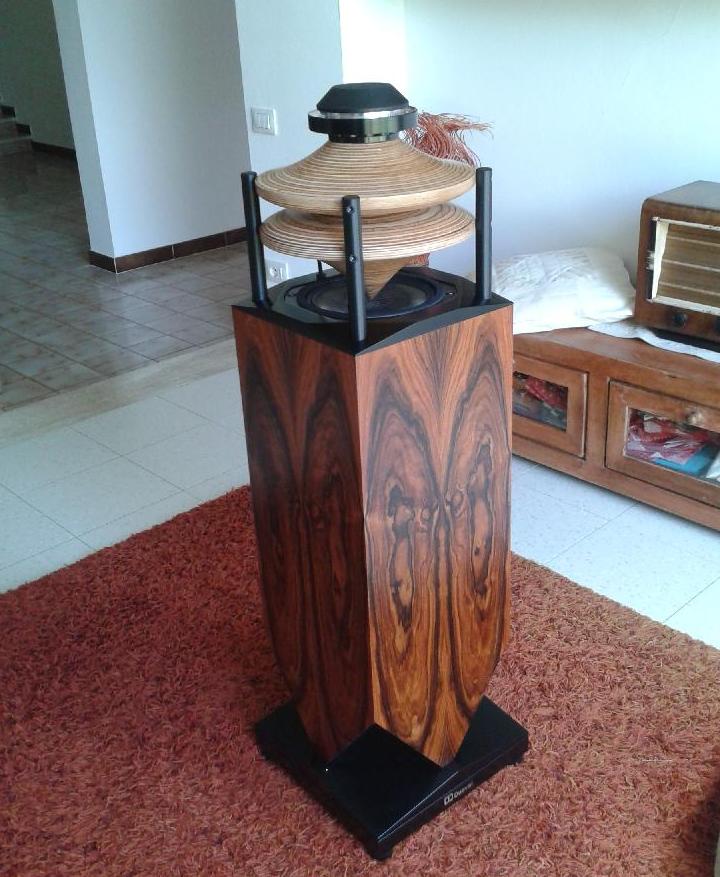
Here is a more ambitious omni project - MBL radialstrahler clone
Summer Project - Replication of MBL loudspeaker 101mkII
I would go the Duevel clone way myself, if I had a big lathe
Transmission line Omni speakers? Duevel Planets clone with transmission line?
This is worth cloning IMO, not too difficult with dsp. Compression driver helps with low efficiency and need for EQ. Bella Luna high end loudspeaker

Can a well balanced dipole (symmetrical front and back) make a good approximation of an omni in room?
- Home
- Loudspeakers
- Multi-Way
- back wave in comparison to front wave
